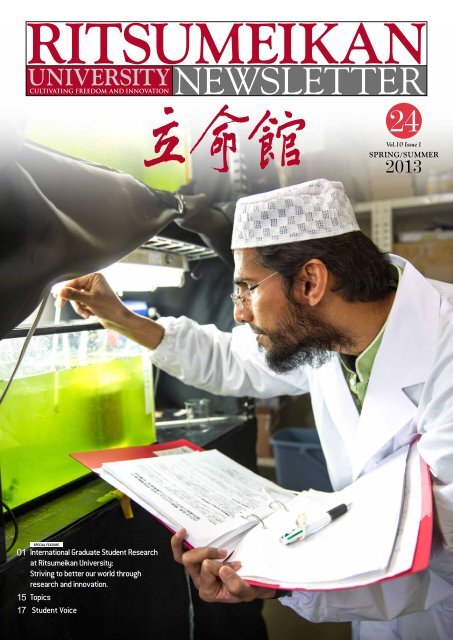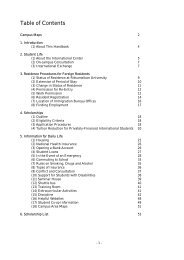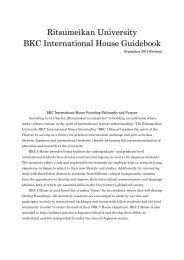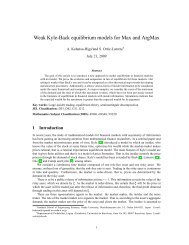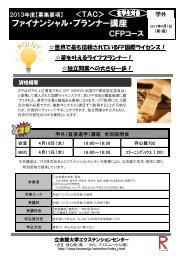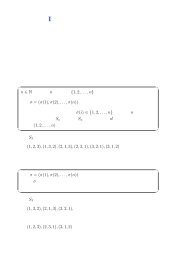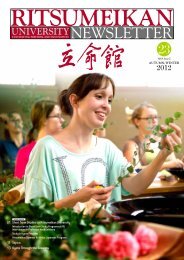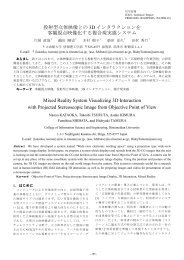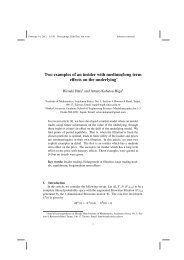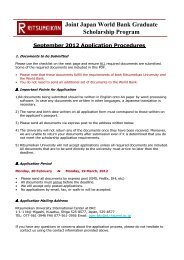International Graduate Student Research at Ritsumeikan University ...
International Graduate Student Research at Ritsumeikan University ...
International Graduate Student Research at Ritsumeikan University ...
You also want an ePaper? Increase the reach of your titles
YUMPU automatically turns print PDFs into web optimized ePapers that Google loves.
24<br />
Vol.10 Issue 1<br />
SPRING/SUMMER<br />
2013<br />
01<br />
15<br />
17<br />
SPECIAL FEATURE<br />
<strong>Intern<strong>at</strong>ional</strong> <strong>Gradu<strong>at</strong>e</strong> <strong>Student</strong> <strong>Research</strong><br />
<strong>at</strong> <strong>Ritsumeikan</strong> <strong>University</strong>:<br />
Striving to better our world through<br />
research and innov<strong>at</strong>ion.<br />
Topics<br />
<strong>Student</strong> Voice
<strong>Ritsumeikan</strong> <strong>University</strong> currently has 486 gradu<strong>at</strong>e<br />
level students from 42 different countries and regions<br />
around the globe who make-up 16% of the gradu<strong>at</strong>e<br />
school student popul<strong>at</strong>ion (as of May 1st, 2013). In terms<br />
of student numbers, most students come from Japan’s close<br />
neighbors in East Asia: China (236 students) and Korea<br />
(46 students). However, the third largest number of intern<strong>at</strong>ional<br />
students <strong>at</strong> the gradu<strong>at</strong>e school level comes from<br />
Indonesia (31 students).<br />
Although some of these intern<strong>at</strong>ional students do possess<br />
the language skills to enter Japanese-based gradu<strong>at</strong>e programs,<br />
there are many programs set up <strong>at</strong> Ritsumiekan for<br />
those whose preferred language of study is English. English<br />
based programs are available in the <strong>Gradu<strong>at</strong>e</strong> Schools of <strong>Intern<strong>at</strong>ional</strong><br />
Rel<strong>at</strong>ions, Policy Science, Economics, Technology<br />
Management, Science and Engineering, Inform<strong>at</strong>ion Science<br />
and Engineering, and Life Sciences. Please click here<br />
(http://www.ritsumei.ac.jp/eng/html/admissions/degree.html/) to<br />
visit the admissions page of the <strong>Ritsumeikan</strong> English website<br />
for more inform<strong>at</strong>ion of English-based programs available.<br />
For many of the potential students who are considering undertaking<br />
gradu<strong>at</strong>e and post-gradu<strong>at</strong>e studies in Japan, financial<br />
support of some kind is critical to their academic endeavors.<br />
<strong>Ritsumeikan</strong> <strong>University</strong> works closely with institutions<br />
like the World Bank and the Ministry of Educ<strong>at</strong>ion to provide<br />
a variety of scholarship options. Furthermore, as of the academic<br />
year 2013 <strong>Ritsumeikan</strong> has reinvented its own scholarship<br />
program to offer 100% tuition reduction to 10 Doctoral<br />
and 20 Master’s students. With these funds, students are<br />
able to focus more on the results of their research and get a<br />
lot more out of their time <strong>at</strong> <strong>Ritsumeikan</strong>. Please click here<br />
(http://www.ritsumei.ac.jp/eng/html/admissions/financial.html/) to<br />
visit the financial support page of the <strong>Ritsumeikan</strong> <strong>University</strong><br />
English website for further details.<br />
Aside from various forms of financial aid, <strong>Ritsumeikan</strong> also<br />
provides various types of student support. This support<br />
ranges from medical and counseling services in both Japanese<br />
and English, to English writing, Japanese language, and<br />
other courses th<strong>at</strong> are free for intern<strong>at</strong>ional students. These<br />
courses are especially helpful for intern<strong>at</strong>ional students as<br />
many of them are coming from countries where English<br />
is not their mother tongue and Japanese language is not<br />
generally taught in school. An intern<strong>at</strong>ional dorm is also<br />
available for interested students. This dorm provides a safe<br />
environment for students to carry out their research activities<br />
and student life.<br />
By having such a wide variety of students undertaking their<br />
research <strong>at</strong> <strong>Ritsumeikan</strong> <strong>University</strong> the campus itself has<br />
evolved into an intern<strong>at</strong>ional setting where it is hoped th<strong>at</strong><br />
multicultural coexistence can be accepted as an everyday<br />
environment. Through stimul<strong>at</strong>ing students’ campus life by<br />
helping to develop their multicultural understanding and<br />
foreign language communic<strong>at</strong>ion skills it is hoped th<strong>at</strong> a<br />
transform<strong>at</strong>ion in the minds of the student body <strong>at</strong> large will<br />
take place and the university will grow into a truly global<br />
research university.<br />
2<br />
Special Fe<strong>at</strong>ure<br />
<strong>Intern<strong>at</strong>ional</strong> <strong>Gradu<strong>at</strong>e</strong> <strong>Student</strong> <strong>Research</strong><br />
<strong>at</strong> <strong>Ritsumeikan</strong> <strong>University</strong>:<br />
Striving to better our world through research and innov<strong>at</strong>ion.<br />
In this growing age of globaliz<strong>at</strong>ion the traditional borders of educ<strong>at</strong>ion have been stripped away, and more than ever, students are<br />
traveling away from their home countries to delve into research <strong>at</strong> the forefront of their respective fields. In a conscious effort to<br />
cre<strong>at</strong>e a truly multicultural campus, <strong>Ritsumeikan</strong> <strong>University</strong> has been accepting intern<strong>at</strong>ional students <strong>at</strong> both the undergradu<strong>at</strong>e and<br />
gradu<strong>at</strong>e levels for many years. In particular, <strong>Ritsumeikan</strong> has taken gre<strong>at</strong> steps to <strong>at</strong>tract top research students <strong>at</strong> the gradu<strong>at</strong>e school<br />
levels. These students come from the world over to carry out research th<strong>at</strong> will not only benefit those in Japan, but will also be taken<br />
back to their home countries and benefit the people of those communities as well.<br />
RITSUMEIKAN UNIVERSITY<br />
NEWSLETTER<br />
SPRING/SUMMER 2013<br />
Cover Picture<br />
The cover picture shows Ph.D student Md.<br />
Mahmudul Hasan as he works on further<br />
developing a simple to make and easy to use<br />
ceramic filter th<strong>at</strong> he hopes will one day help<br />
those in need of safe and clean w<strong>at</strong>er around the<br />
world over.<br />
Order of Names<br />
In this public<strong>at</strong>ion, the name order for<br />
personal names preserves the original order<br />
of the n<strong>at</strong>ionality in question. For example,<br />
Japanese, Chinese, and Korean names are<br />
presented in the surname/given name order,<br />
while the given name/surname order is used<br />
for people from Western countries.<br />
The word ritsumei comes from a passage in the<br />
Jinxin chapter of the Discourses of Mencius. This<br />
passage st<strong>at</strong>es, ”Some die young, as some live<br />
long lives. This is decided by f<strong>at</strong>e. Therefore,<br />
one’s duty consists of cultiv<strong>at</strong>ing one’s<br />
mind during this mortal span and thereby<br />
establishing one’s destiny.” Thus, <strong>Ritsumeikan</strong><br />
means ”the place to establish one’s destiny.”<br />
Organiz<strong>at</strong>ion of <strong>Ritsumeikan</strong><br />
The <strong>Ritsumeikan</strong> Trust is the legal entity th<strong>at</strong> oper<strong>at</strong>es the entire<br />
<strong>Ritsumeikan</strong> Academy, which is comprised of <strong>Ritsumeikan</strong> <strong>University</strong>,<br />
<strong>Ritsumeikan</strong> Asia Pacific <strong>University</strong>, and the affili<strong>at</strong>e secondary<br />
schools. In this public<strong>at</strong>ion, ”<strong>Ritsumeikan</strong>” is used to refer to the<br />
<strong>Ritsumeikan</strong> Academy, while RU and APU refer to <strong>Ritsumeikan</strong><br />
<strong>University</strong> and <strong>Ritsumeikan</strong> Asia Pacific <strong>University</strong>, respectively.<br />
Published by<br />
Office of Public Rel<strong>at</strong>ions,<br />
<strong>Ritsumeikan</strong> <strong>University</strong><br />
Designed by<br />
Delights, Inc.<br />
*In this public<strong>at</strong>ion, the Japanese Ministry of Educ<strong>at</strong>ion, Culture, Sports, Science and Technology is referred to as the Ministry of Educ<strong>at</strong>ion.
Maharani Retna Duhita (Nana)<br />
4<br />
Press here to play movie in full screen, high quality.<br />
Name Maharani Retna Duhita (Nana)<br />
Country Indonesia<br />
Faculty <strong>Gradu<strong>at</strong>e</strong> School of Life Sciences<br />
<strong>Research</strong> Field Immuneuroendocrinology / Biomedical Science<br />
Special Fe<strong>at</strong>ure<br />
Maharani Retna Duhita (or Nana, as she is known to her friends) is a 1st year Master’s student<br />
in the <strong>Gradu<strong>at</strong>e</strong> School of Life Sciences and is currently investig<strong>at</strong>ing complex and yet undiscovered<br />
rel<strong>at</strong>ions between our immune, endocrine, and nervous systems. By bringing these<br />
rel<strong>at</strong>ions to light it is hoped th<strong>at</strong> new cures and tre<strong>at</strong>ments for a variety of diseases will be<br />
discovered.<br />
Uncovering disease mechanics to discover<br />
new therapies and cures.<br />
Q<br />
Please explain your research.<br />
A My research area is about immunoneuroendocrinology,<br />
so I want to know the close rel<strong>at</strong>ion between<br />
immune systems, endocrine systems, and nervous<br />
systems. Previous studies showed th<strong>at</strong> immune<br />
receptors can not only be found in immune systems<br />
but can also be found in endocrine and nervous systems,<br />
and nervous and endocrine systems can also be<br />
found in immune systems. Now, I work with insulin<br />
hormones. I try to culture several immune cells and<br />
measure the insulin level in those cultures. In the<br />
future I want to study the leptin levels in those immune<br />
cell cultures and understand the correl<strong>at</strong>ion<br />
between insulin and leptin levels in immune systems.
Uncovering disease mechanics to discover<br />
new therapies and cures.<br />
Maharani Retna Duhita (Nana)<br />
Why did you choose to focus your<br />
Q research on this topic?<br />
A In my opinion, if I can understand the whole<br />
mechanism about immunoneuroendocrinology systems<br />
in humans, it will be helpful in the future. By<br />
activity. Not only in research activity, they also<br />
Wh<strong>at</strong> do you plan to do when you return<br />
understanding this mechanism I could explain briefly<br />
about the p<strong>at</strong>hological mechanism of diseases and<br />
They also study English with me. It was very nice Q Japan after completing your research<br />
teach me Japanese language and Japanese culture.<br />
home? Or do you plan on working in<br />
hopefully I can discover the best therapeutic str<strong>at</strong>egy<br />
when I saw they can speak English fluently now.<br />
here <strong>at</strong> <strong>Ritsumeikan</strong>?<br />
for several diseases. It’s my dream since child-<br />
hood to be useful for other people and help them to<br />
Wh<strong>at</strong> are some challenges you are facing<br />
Q A I will take my Ph.D after I finish my Master’s<br />
solve their problems. And this is my way to realize<br />
everyone always gives me strong support to study<br />
with your research<br />
Degree <strong>at</strong> <strong>Ritsumeikan</strong> <strong>University</strong>. After completing<br />
th<strong>at</strong> dream.<br />
here and do my own research. They always encourage<br />
me if I have problems in my class or in my re-<br />
university, set up my own labor<strong>at</strong>ory, try challenging<br />
my Ph.D I will go back to my country and teach in<br />
Have you had any opportunities to<br />
search activity. I am not sure I would have conditions<br />
similar to Japan in Indonesia. Actually I think<br />
my research area.<br />
A My research activity is rel<strong>at</strong>ed with hormones,<br />
and immune cells, so the most important<br />
6<br />
something new, and discover new things rel<strong>at</strong>ed with<br />
5 present your research <strong>at</strong> RU/outside of<br />
Q RU?<br />
it would be totally different. In Indonesia, I would<br />
thing is accuracy, because if small mistakes occur in<br />
have to struggle with many problems th<strong>at</strong> can inhibit<br />
my study and research because many people don’t<br />
one step, it will affect all the following steps and destroy<br />
whole systems. Because I also work with cell<br />
A Last semester, I presented my research in my<br />
<strong>Ritsumeikan</strong> <strong>University</strong>, <strong>Gradu<strong>at</strong>e</strong> Project Class, in<br />
front of the President of <strong>Ritsumeikan</strong> <strong>University</strong>, un-<br />
understand the importance of research activities.<br />
cultures, the challenges is to avoid any form of contamin<strong>at</strong>ion.<br />
On the other hand, the most difficult<br />
dergradu<strong>at</strong>e and gradu<strong>at</strong>e students, and also several<br />
different companies. This was a gre<strong>at</strong> opportunity to<br />
explain about my research in front of other people.<br />
In the end of this 2nd semester, I plan to <strong>at</strong>tend an<br />
intern<strong>at</strong>ional conference outside Japan, which is rel<strong>at</strong>ed<br />
to my research area.<br />
How is carrying out this research <strong>at</strong><br />
<strong>Ritsumeikan</strong> different than if you were<br />
Q back in Indonesia?<br />
A I am very gr<strong>at</strong>eful I can take my Master’s<br />
Degree and do my own research in Japan. In Japan,<br />
How are the other Japanese/<br />
intern<strong>at</strong>ional students assisting you with<br />
Q your research?<br />
A They are very helpful. They always assist<br />
and help me when I have a problem in my research<br />
thing in scientific research is to find something new,<br />
because our research activity will be in vain if another<br />
researcher has already published the same results<br />
as research. Th<strong>at</strong>’s why I must check all the<br />
liter<strong>at</strong>ure and keywords for my research to see if they<br />
are already published or not.<br />
Special Fe<strong>at</strong>ure<br />
Special Fe<strong>at</strong>ure
Robert Oliver Ladig<br />
8<br />
Press here to play movie in full screen, high quality.<br />
Name Robert Oliver Ladig<br />
Country Germany<br />
Faculty <strong>Gradu<strong>at</strong>e</strong> School of Science and Engineering<br />
<strong>Research</strong> Field Integr<strong>at</strong>ed Sensors and Image Analysis<br />
Special Fe<strong>at</strong>ure<br />
Robert Oliver Ladig is a 1st year gradu<strong>at</strong>e student from Germany currently working on the<br />
development of an autonomous flying robot, a so-called quadrotor. Although centered on “Integr<strong>at</strong>ed<br />
Sensors and Image Analysis,” this research also extends through the study of flight<br />
dynamics, computer programing, robotics and even the development and cre<strong>at</strong>ion of components<br />
through the use of st<strong>at</strong>e-of-the-art, in-lab 3D printers.<br />
Developing autonomous flying robots for<br />
search and rescue in disaster areas.<br />
Wh<strong>at</strong> is the focus of your research here<br />
Q <strong>at</strong> <strong>Ritsumeikan</strong> <strong>University</strong>?<br />
A Here <strong>at</strong> <strong>Ritsumeikan</strong> I am working on an indoor<br />
navig<strong>at</strong>ion algorithm for flying robots. A current<br />
hurdle with the use of flying robots is indoor flight. Although<br />
outdoor navig<strong>at</strong>ion is r<strong>at</strong>her simple through the<br />
use of the Global Positioning System (GPS), once a robot<br />
is moved indoors or other confined spaces it can no<br />
longer utilize GPS or other tracking systems th<strong>at</strong> rely<br />
on s<strong>at</strong>ellite transmissions from space. There are many<br />
approaches to solving the issues of indoor tracking for<br />
robots, but my approach is to try and emul<strong>at</strong>e how insects<br />
navig<strong>at</strong>e in confined spaces. This is why my first<br />
prototype is called the “Ritsubachi” after the Japanese<br />
for honey-bee (mitsubachi/ 蜜 蜂 ). At this stage in my<br />
research, the current prototype is not very small, but<br />
the basic navig<strong>at</strong>ion will be similar to how insects navig<strong>at</strong>e<br />
through confined spaces.
Developing autonomous flying robots for<br />
search and rescue in disaster areas.<br />
Robert Oliver Ladig<br />
RITSUBACHI: This is the name given to the quadrotor pictured below.<br />
Made up of two parts, the name is a combin<strong>at</strong>ion of “<strong>Ritsumeikan</strong>”<br />
and the word HACHI ( 蜂 ) which is Japanese for bee. As the<br />
flight algorithm being developed for this quadrotor is based on insect<br />
flight dynamics it would seem to be quite an appropri<strong>at</strong>e name.<br />
Wh<strong>at</strong> is the main goal for your<br />
Q Ritsubachi quadrotor?<br />
A It is my hope th<strong>at</strong> someday my developments<br />
will be used in actual search and rescue missions and<br />
th<strong>at</strong> I may be able to contribute to the rescue of people<br />
in need after a disaster has occurred. My flight algorithm<br />
is being developed specifically for indoor navig<strong>at</strong>ion,<br />
so if there is a need to navig<strong>at</strong>e an unknown indoor<br />
environment, this algorithm should be able to<br />
really help people in trouble.<br />
The main object is to use this in disaster<br />
rescue, but how would this be utilized in<br />
Q a real world situ<strong>at</strong>ion?<br />
Special Fe<strong>at</strong>ure<br />
A When there is a disaster and people are<br />
trapped inside buildings under fallen objects, it is essential<br />
to act as quickly as possible to rescue these<br />
people. When I finish my project, you could deploy not<br />
one, but several devices th<strong>at</strong> could find a building and<br />
go inside by GPS, then move in and switch to my indoor<br />
navig<strong>at</strong>ion algorithm. From there the Ritsubachi<br />
would make a structural map and find situ<strong>at</strong>ions of interest:<br />
For example, a person trapped in the building.<br />
As the quadrotor is airborne, there should be less hindrance<br />
inside the building (this is a big advantage over<br />
ground-based robots which need to worry about rubble<br />
and other debris) and thus return quickly so th<strong>at</strong> rescue<br />
teams may analyze the inform<strong>at</strong>ion and quickly<br />
send help to those in need.<br />
Wh<strong>at</strong> are some of the new technologies<br />
you have been able to utilize in your<br />
Q project?<br />
A There is a chip I am using called a Field Programmable<br />
G<strong>at</strong>e Array (FPGA). Wh<strong>at</strong> is special about a<br />
FPGA is th<strong>at</strong> you can basically design the chip to be any<br />
kind of chip you want it to be. For example, the chip in<br />
your computer can do many things like games, m<strong>at</strong>hem<strong>at</strong>ics,<br />
graphics, pretty much anything. FPGAs on the<br />
other hand are very specific in use, so you program them<br />
to do only one thing. But it does this one thing very, very<br />
fast, and with low energy consumption costs.<br />
Also, all the sensors I am using are quite high tech.<br />
This project would not have been possible 10 years ago<br />
as the sensors would have been impossible for anyone<br />
(except the military) to afford. In this one quadrotor<br />
alone there are three gyro sensors, three accelerometers,<br />
a pressure sensor, a GPS, etc,. And even with<br />
all these sensors it is still rel<strong>at</strong>ively inexpensive for my<br />
research, or for organiz<strong>at</strong>ions th<strong>at</strong> would want to use it.<br />
Right now this prototype would only cost about 50,000<br />
yen. It is a very affordable system and th<strong>at</strong> is why I hope<br />
it will be utilized in many search and rescue missions in<br />
the future.<br />
Lastly, some parts I am using for my quadrotor are 3D<br />
printed. This means I designed some parts myself, such<br />
as the base the FPGA rests on, and then printed them<br />
out with our 3D printer here in the lab. This is very<br />
useful as you don’t have to order special parts or improvise<br />
with parts you find in the lab. You can design a part<br />
on the computer, test the stress levels before printing,<br />
then print it and have a very nice (and inexpensive)<br />
custom part to use.<br />
Is this the final size you would like the<br />
robot? How would you like to develop<br />
Q this further?<br />
A This is only a prototype size. At first it is very<br />
convenient to build it this size as I can easily add new sensors,<br />
etc., and not worry if it will be too heavy to fly or not.<br />
Of course, the goal is to make it much smaller. When I am<br />
finished testing and know the basic navig<strong>at</strong>ion algorithum<br />
works my goal it to make it smaller, but th<strong>at</strong> might be a<br />
goal for my Ph.D, which I also hope to be able to carry out<br />
<strong>at</strong> <strong>Ritsumeikan</strong> <strong>University</strong>.<br />
Wh<strong>at</strong> are some challenges you are<br />
Q finding with your research?<br />
A There are lots of challenges, but in particular one<br />
thing I underestim<strong>at</strong>ed was flight dynamics. As a computer<br />
engineer, I understand my computer, programing,<br />
and engineering. But flight dynamics is quite new for me<br />
so th<strong>at</strong> has been quite a challenge since I started the project.<br />
To overcome this I read a lot of books on helicopter<br />
dynamics, which was actually a lot of fun as helicopters<br />
were a big interest of mine as a child and I hope to one day<br />
get my helicopter license when I have the opportunity. It<br />
is a challenge but still enjoyable.<br />
How has studying <strong>at</strong> <strong>Ritsumeikan</strong> and<br />
not in Germany helped you with your<br />
Q research?<br />
A First of all I don’t think I would have been able to<br />
do this kind of research in Germany. At <strong>Ritsumeikan</strong> I feel<br />
I am given the opportunity to do a lot more than if I was<br />
in Germany. Here I am able to do my own research project<br />
on my own responsibility. Furthermore, when I need any<br />
parts for my robot, I ask my professor and most of the time<br />
I am able to integr<strong>at</strong>e this part quickly in my project. This<br />
is just not the case in Germany. In Germany, it is very hard<br />
to get financing for your projects, especially if it is only a<br />
gradu<strong>at</strong>e project. So I don’t think I could do my research<br />
as I do here <strong>at</strong> <strong>Ritsumeikan</strong>. It gives me lots of opportunities<br />
and freedom to do my research in Japan. Furthermore,<br />
Japan is one of the few countries where my research can<br />
not be exploited for military means, since the Japanese<br />
people forever renounced war in their constitution. I am<br />
putting in a lot of time and effort in my project, but I am<br />
always getting something positive out of this work.<br />
Special Fe<strong>at</strong>ure<br />
9 10
Md. Mahmudul Hasan<br />
12<br />
Press here to play movie in full screen, high quality.<br />
Name Md. Mahmudul Hasan<br />
Country Bangladesh<br />
Faculty <strong>Gradu<strong>at</strong>e</strong> School of Science and Engineering<br />
<strong>Research</strong> Field W<strong>at</strong>er Tre<strong>at</strong>ment and Reuse<br />
Special Fe<strong>at</strong>ure<br />
MD. Mahmudul Hasan has finished his Master’s Degree <strong>at</strong> <strong>Ritsumeikan</strong> <strong>University</strong> and is currently<br />
in his 2nd year of his Ph.D program. He started his study <strong>at</strong> <strong>Ritsumeikan</strong> <strong>University</strong><br />
through his master’s course and then continued onto the doctoral course. Initially working on<br />
the removal of arsenic from groundw<strong>at</strong>er with the use of a simple and inexpensive ceramic filter,<br />
he has expanded his research to include a wide variety of w<strong>at</strong>er sectors and one day hopes<br />
to take these filters back to Bangladesh to help improve the quality of life for all of its people.<br />
Providing clean w<strong>at</strong>er through the development<br />
of innov<strong>at</strong>ive yet inexpensive ceramic filters.<br />
Wh<strong>at</strong> is the focus of your research into<br />
Q the tre<strong>at</strong>ment of w<strong>at</strong>er?<br />
A My research is focused on the development of<br />
simple, innov<strong>at</strong>ive, inexpensive and effective technologies<br />
for wastew<strong>at</strong>er reclam<strong>at</strong>ion and reuse based on the<br />
“3R” (reduce, reuse & recycle) principle. In our labor<strong>at</strong>ory<br />
we developed a simple ceramic filter made of clay soil<br />
and rice bran (80:20 by weight) for the removal of arsenic<br />
from groundw<strong>at</strong>er. Outside of our lab, the ceramic filter<br />
achieved high levels of arsenic removal over one full year<br />
of oper<strong>at</strong>ion in a rural area of Bangladesh. The successful<br />
results of this trial pushed us to apply this simple and low<br />
cost ceramic filter for wastew<strong>at</strong>er reclam<strong>at</strong>ion.<br />
From there, I investig<strong>at</strong>ed possible applic<strong>at</strong>ions of this<br />
simple ceramic filter with the membrane bioreactor<br />
(MBR) process, r<strong>at</strong>her than conventional membranes,<br />
under two different filtr<strong>at</strong>ion modes (gravit<strong>at</strong>ional and<br />
suction) with different oper<strong>at</strong>ional conditions through
Providing clean w<strong>at</strong>er through the development<br />
of innov<strong>at</strong>ive yet inexpensive ceramic filters.<br />
Md. Mahmudul Hasan<br />
lab scale experiments. The successful results confirmed<br />
th<strong>at</strong> its applic<strong>at</strong>ion makes the MBR process cost-effective<br />
and energy-efficient enough to effectively make use of the<br />
w<strong>at</strong>er in Bangladesh, but when we switched to tre<strong>at</strong>ing<br />
wastew<strong>at</strong>er we felt this size was too small, so we made the<br />
filters longer, and also reshaped it as a fl<strong>at</strong>-type filter.<br />
and if this is successful, we will have three different sources<br />
of w<strong>at</strong>er we are able to tre<strong>at</strong> and reuse by using this<br />
simple and low-cost ceramic filter. The next step is now<br />
we work in groups of 5-6 people and share our work load.<br />
In this way new students are able to work with senior students<br />
in the lab and learn firsthand from their research<br />
filter in developing countries. And now the applic<strong>at</strong>ion<br />
proposing this technology in a commercial sense to help and acquired knowledge.<br />
This filter is very easy to make with a very simple manufacturing<br />
process. Rice bran and clay soil are two m<strong>at</strong>eri-<br />
of this ceramic filter is being tested for the Wastew<strong>at</strong>er<br />
developing countries like Bangladesh, Thailand, and<br />
Stabiliz<strong>at</strong>ion Ponds (WSPs) process to remove algae under<br />
different oper<strong>at</strong>ional factors through lab scale experi-<br />
real problems.<br />
Vietnam where a safe w<strong>at</strong>er supply and w<strong>at</strong>er scarcity are<br />
als in abundance in Bangladesh, and are cheap as well.<br />
When you finish here <strong>at</strong> RU will you<br />
So, cheap, easy to obtain m<strong>at</strong>erials and a simple manufacturing<br />
process are the keys to this project. To manufac-<br />
Q return to Bangladesh?<br />
ments.<br />
Besides wastew<strong>at</strong>er sectors, I am also looking <strong>at</strong> the tre<strong>at</strong>ment<br />
of surface w<strong>at</strong>er, such as pond w<strong>at</strong>er in rural areas a filter breaks, it is very easy and cheap to replace. This Q present your work here in Japan? A Yes, of course. I would like to make use of my<br />
ture one 10 cm by 10 cm filter, it costs less than $0.24. If<br />
Have you had any opportunities to<br />
of Bangladesh, using this ceramic filter. We already surveyed<br />
our study area (Khulna, Bangladesh) <strong>at</strong> two dif-<br />
be able to maintain, replace, and even produce by them-<br />
is something th<strong>at</strong> anyone in developing countries would<br />
research in Bangladesh and do wh<strong>at</strong> I can to improve the<br />
situ<strong>at</strong>ion there. However, before moving back I would like<br />
ferent times (dry season and wet season) to collect the selves, they don’t need to be highly skilled to do this kind<br />
A Yes, I presented <strong>at</strong> the 4th <strong>Intern<strong>at</strong>ional</strong> W<strong>at</strong>er to work here in Japan for two or three years to gain working<br />
pond d<strong>at</strong>a. After assessing the collected pond w<strong>at</strong>er d<strong>at</strong>a,<br />
we will select the pond for the tre<strong>at</strong>ment and propose a<br />
of work.<br />
Associ<strong>at</strong>ion (IWA) conference in Tokyo. At th<strong>at</strong> time I<br />
presented our successful removal of arsenic from groundw<strong>at</strong>er<br />
experience and professional knowledge. Just experi-<br />
mental knowledge is not enough, I need to understand<br />
in Bangladesh and the findings from our one-year the real technologies being utilized in the field. Also, as I<br />
design of a small tre<strong>at</strong>ment facility using the ceramic filter.<br />
Finally, we have planned to construct the tre<strong>at</strong>ment<br />
13<br />
If there a large necessity for this kind of<br />
14<br />
field test with our filters in 15 households in Bangladesh. have been studying here in Japan for 5 years now, I fully<br />
Q research?<br />
facility in our research area and evalu<strong>at</strong>e its sustainability.<br />
understand the university environment, yet I do not understand<br />
the Japanese working environment, but I need<br />
this knowledge as well as I wish to move into the professional<br />
world.<br />
A Yes, of course! If I focus on developing countries,<br />
especially my home country, Bangladesh, there is a large<br />
Special Fe<strong>at</strong>ure<br />
Please explain how these ceramic filters<br />
Q are made.<br />
A As I said, this filter is made with rice bran and<br />
clay soil which is from Bangladesh. This is because the soil<br />
in Bangladesh has a much higher clay content and if we<br />
use soil with too much sand, the filter will not harden<br />
properly and it will become too brittle. To cre<strong>at</strong>e a filter a<br />
mold is made and shaped in a cylindrical shape with one<br />
end closed. The first filters we made ended up small <strong>at</strong> 10<br />
cm by 10 cm in dimension. These are then sun-dried for<br />
one or two days, then placed in an oven <strong>at</strong> 105 ℃ for one<br />
day, and then burnt <strong>at</strong> 900 ℃ for two hours. Initially,<br />
these filters were designed to remove arsenic from ground-<br />
problem with safe groundw<strong>at</strong>er. Until about 1970, people<br />
in Bangladesh utilized surface w<strong>at</strong>er, but <strong>at</strong> th<strong>at</strong> time organiz<strong>at</strong>ions<br />
such as UNICEF and the UN recommended the<br />
use of ground w<strong>at</strong>er because surface w<strong>at</strong>er can be contamin<strong>at</strong>ed<br />
by a variety of p<strong>at</strong>hogens. So, a huge amount of<br />
wells were dug in Bangladesh over the next 20 years or so.<br />
This has given access to safe w<strong>at</strong>er to 95% of the rural<br />
households, but unfortun<strong>at</strong>ely, in the early 1990s, the well<br />
w<strong>at</strong>er in Bangladesh was found to be highly contamin<strong>at</strong>ed<br />
with arsenic (As) and now millions of people are consuming<br />
arsenic-contamin<strong>at</strong>ed drinking w<strong>at</strong>er, which is very<br />
toxic for the human body. So, since 1990, a large amount<br />
of research has been carried out to figure out how to tre<strong>at</strong><br />
the contamin<strong>at</strong>ed groundw<strong>at</strong>er. Based on this initial problem,<br />
we have developed our filter to remove the arsenic<br />
from the drinking w<strong>at</strong>er. And from our successful results<br />
we found th<strong>at</strong> our filters could also be used for wastew<strong>at</strong>er<br />
tre<strong>at</strong>ment as well. So, once we solved the issue with arsenic<br />
in the drinking w<strong>at</strong>er, we have now moved to the<br />
tre<strong>at</strong>ment of wastew<strong>at</strong>er and we again succeeded to apply<br />
the filter in wastew<strong>at</strong>er sectors. Now we have actually<br />
started focusing on pond w<strong>at</strong>er (i.e. surface w<strong>at</strong>er) as well,<br />
How are your professor and fellow<br />
Q students helping you with your studies?<br />
A Well, I have had the same professor since 2008<br />
but I still feel there is a language barrier <strong>at</strong> times. Frankly<br />
speaking, Japanese is very difficult for me. Actually, this<br />
lab is very intern<strong>at</strong>ional with roughly 5-6 new intern<strong>at</strong>ional<br />
students from several different countries joining<br />
the lab each year. This makes our lab a very intern<strong>at</strong>ional<br />
environment, more so than most labs on campus, but we<br />
still face this challenge of the language barriers.<br />
Saying th<strong>at</strong>, through my courses and research I find th<strong>at</strong><br />
my professors are very knowledgeable and have been able<br />
to help me each step of the way. Also, my Japanese and intern<strong>at</strong>ional<br />
lab partners are very helpful, as here in Japan<br />
Also, there is already an NGO helping us in Bangladesh,<br />
and we already got our p<strong>at</strong>ent for our arsenic removal<br />
filter. Now we are waiting for its verific<strong>at</strong>ion results by<br />
the Bangladesh government. Once we get this we can go<br />
through commercially to supply the low-cost filter to poor<br />
rural people. Besides this, industry is growing in Bangladesh<br />
so plants will need wastew<strong>at</strong>er tre<strong>at</strong>ment facilities,<br />
and now in Bangladesh and other developing countries<br />
the demand is growing for low-cost decentralized or centralized<br />
wastew<strong>at</strong>er tre<strong>at</strong>ment facilities <strong>at</strong> the municipal<br />
level, so if this cheap and innov<strong>at</strong>ive technology can help<br />
them and thus the country <strong>at</strong> large, this is gre<strong>at</strong>!<br />
Special Fe<strong>at</strong>ure
T O P I C S<br />
R i t s u m e i k a n U n i v e r s i t y<br />
R i t s u m e i k a n A s i a P a c i f i c U n i v e r s i t y<br />
RU<br />
Japan Semester of the Campus Asia Program Starts!<br />
APU<br />
APU selected as Executive Trustee School of the Associ<strong>at</strong>ion<br />
of Asia-Pacific Business Schools<br />
From Tuesday, May 7th, students chosen from <strong>Ritsumeikan</strong><br />
<strong>University</strong>, Guangdong <strong>University</strong> of Foreign Studies<br />
(China) and Dongseo <strong>University</strong> (Korea) started the second<br />
semester (Japan) of the Campus Asia program which is being<br />
held <strong>at</strong> <strong>Ritsumeikan</strong>’s Kinugasa Campus for the next<br />
three months.<br />
The <strong>Ritsumeikan</strong> Asia Pacific <strong>University</strong> (APU) College of <strong>Intern<strong>at</strong>ional</strong><br />
Management (APM) and <strong>Gradu<strong>at</strong>e</strong> School of Management (GSM) have<br />
been collectively selected as an Executive Trustee School <strong>at</strong> the Annual<br />
Conference of the Associ<strong>at</strong>ion of Asia-Pacific Business Schools (AAPBS),<br />
an intern<strong>at</strong>ional associ<strong>at</strong>ion<br />
dedic<strong>at</strong>ed to the<br />
Kenji, <strong>at</strong>tended the AAPBS Annual Conference and addressed the audience<br />
following APU’s selection as an Executive Trustee School: “We are<br />
honored to have this opportunity to develop gre<strong>at</strong>er links with such<br />
globally renowned business schools. We look forward to contributing to<br />
AAPBS by providing fellow members with Japanese and Asian business<br />
case studies we have developed <strong>at</strong> GSM”.<br />
To start the Japan semester of the Campus Asia program,<br />
promotion of business<br />
APU has been a member of AAPBS since 2008 and will begin its term as<br />
the director of the program here in Japan, Professor K<strong>at</strong>surajima<br />
Nobuhiro (Dean, College of Letters) gave a short<br />
in the Asia Pacific re-<br />
educ<strong>at</strong>ion and research<br />
an Executive Trustee School in January 2013. A total of 14 institutes in<br />
10 different countries/regions serve as Executive Trustee Schools including<br />
only two in Japan – Keio <strong>University</strong> and APU. As an Executive Trustee<br />
opening speech to all the particip<strong>at</strong>ing students. Professor<br />
gion. This selection reflects<br />
the recognition<br />
K<strong>at</strong>surajima st<strong>at</strong>ed th<strong>at</strong> “with its rich 1,300 years of history,<br />
School, APU will play an increasing role in the management of AAPBS<br />
Kyoto is known as the cultural heart of Japan and is thus a<br />
APU has received for<br />
and the Annual Conferences.<br />
perfect spot for everyone to study and absorb the culture<br />
its intern<strong>at</strong>ional educ<strong>at</strong>ion<br />
and history of East Asia. It can be said th<strong>at</strong> the governmental<br />
rel<strong>at</strong>ions between our three countries are less than ideal <strong>at</strong><br />
systems and the<br />
APU <strong>Gradu<strong>at</strong>e</strong> School<br />
the moment, but I feel this program is a good step in fostering<br />
cordial rel<strong>at</strong>ions throughout East Asia in the near future.<br />
students can study Japa-<br />
of Management, where<br />
The official Associ<strong>at</strong>ion of Asia Pacific Business Schools (AAPBS) website:<br />
http://www.aapbs.org/<br />
Please utilize the short time you have here and work with all<br />
nese business entirely in<br />
As the program gets in motion, students will particip<strong>at</strong>e in field work<br />
your energy towards your goals.”<br />
English.<br />
<strong>Ritsumeikan</strong> Asia Pacific <strong>University</strong>, College of <strong>Intern<strong>at</strong>ional</strong> Management (APM)<br />
to learn about Kyoto’s culture and history, while using history textbooks<br />
15 Facts and Figures:<br />
16<br />
Following this, faculty and staff members of the Campus Asia program published by Yamakawa Shuppansha(Ltd.) to learn about modern history.<br />
Furthermore, outside of class, students will also have the opportu-<br />
<strong>Intern<strong>at</strong>ional</strong> Manage-<br />
Dean of the College of<br />
http://www.apu.ac.jp/home/study/index.php?content_id=7<br />
gave self-introductions, which were followed by a short guidance on<br />
living in Japan. After the guidance, students were separ<strong>at</strong>ed based on nity to particip<strong>at</strong>e in local festivals, to visit disaster-affected regions of<br />
ment and <strong>Gradu<strong>at</strong>e</strong> <strong>Ritsumeikan</strong> Asia Pacific <strong>University</strong>, <strong>Gradu<strong>at</strong>e</strong> School of Management (GSM)<br />
their dormitory, where they will live for the next three months, and Japan, and particip<strong>at</strong>e in peace studies held <strong>at</strong> the Kyoto Museum for<br />
School of Management, Facts and Figures:<br />
d<strong>at</strong>es were set for future housing guidance sessions.<br />
World Peace, <strong>Ritsumeikan</strong> <strong>University</strong>.<br />
Professor Yokoyama http://www.apu.ac.jp/gradu<strong>at</strong>e/page/content0046.html<br />
TOPICS<br />
TOPICS<br />
RU<br />
Memorial Signing Held to Enrich Japanese Educ<strong>at</strong>ion<br />
in the United Arab Emir<strong>at</strong>es<br />
APU<br />
APU welcomes 20 St Edward’s <strong>University</strong> <strong>Student</strong>s<br />
for the “Business in Japan” Study Program:<br />
A Memorandum of Understanding (“MOU”) has been signed by represent<strong>at</strong>ives<br />
of Cosmo Oil Co., Ltd. (“Cosmo Oil”), Abu Dhabi Oil Co.,<br />
Ltd. (“ADOC”), a subsidiary of Cosmo Oil, and the <strong>Ritsumeikan</strong> Trust<br />
(“<strong>Ritsumeikan</strong>”), on one hand and the represent<strong>at</strong>ive of the Abu Dhabi<br />
Educ<strong>at</strong>ion Council (“ADEC”) on the other hand, with the objectives of<br />
(1) the expansion of the Japanese Language Teaching Program (“JLTP”)<br />
in the Applied Technology High School (“ATHS”) Abu Dhabi premises<br />
which started from September 2011, (2) the expansion of cooper<strong>at</strong>ion<br />
in various areas such as receiving students from Abu Dhabi, and (3)<br />
further discussing the conditions to receive students from Abu Dhabi.<br />
D<strong>at</strong>e<br />
Place<br />
Singers<br />
May 1st, 2013<br />
Jumeirah Etihad Towers in Abu Dhabi, U.A.E.<br />
H.E. Augheer Al Khaili, Director General, ADEC<br />
Mr. Yukihiro Tanaka, Represent<strong>at</strong>ive & General Manager, ADOC<br />
Mr. S<strong>at</strong>oshi M<strong>at</strong>sui, General Manager, Cosmo Oil<br />
Mr. Kiyofumi Kawaguchi, Chancellor of <strong>Ritsumeikan</strong><br />
Cosmo Oil, ADOC and <strong>Ritsumeikan</strong> commenced the “COSMO ADOC<br />
<strong>Ritsumeikan</strong> Japanese Language Teaching Program(JLPT)” in September,<br />
2011. Cosmo Oil and ADOC give financial support of the JLTP. <strong>Ritsumeikan</strong><br />
provides technical support for three Japanese teachers working in Abu<br />
Dhabi, and also designs and supervises the curriculum of the program.<br />
Under the JLTP, 48 students in Grade 10 and 11 <strong>at</strong> the ATHS currently<br />
study the Japanese language. In 2012, 10 students came to Japan and<br />
studied for a short term <strong>at</strong> the <strong>Ritsumeikan</strong> High School, and 24 students<br />
studied <strong>at</strong> the <strong>Ritsumeikan</strong> Uji High School.<br />
As the governments of both Japan and U.A.E. highly appreci<strong>at</strong>e this program,<br />
both sides pledged to further enhance the educ<strong>at</strong>ional contribution<br />
under the MOU, and th<strong>at</strong> the children in the U.A.E. will have more<br />
understanding of Japanese language and culture, as they will become<br />
c<strong>at</strong>alysts for excellent bil<strong>at</strong>eral rel<strong>at</strong>ionships in the future.<br />
From Sunday, March 10, until Sunday, March 17, 2013, APU hosted 20<br />
undergradu<strong>at</strong>e students from St Edward’s <strong>University</strong> (Texas, USA) for the<br />
“Business in Japan” study program. Involving business-rel<strong>at</strong>ed lectures<br />
by APU faculty, industry inspection field trips, and cultural exchange.<br />
This program was held as part of the Global Collabor<strong>at</strong>ive <strong>University</strong><br />
Educ<strong>at</strong>ion (GLUE) program between APU and SEU.<br />
Staying <strong>at</strong> AP House 3, the students took part in ice-breaking games<br />
organized by APU student buddies and a tour of the campus. Their buddies<br />
also accompanied them on a tour of Beppu city including the famous<br />
“Hells” hot-springs and a hot-spring steamed cooking experience.<br />
On March 12 the group received a lecture by APM Professor Nakayama<br />
Haruo on the subject of “Challenges Facing the Japanese Economy”<br />
during which he described a wide range of issues including Japan’s aging<br />
popul<strong>at</strong>ion, economic stagn<strong>at</strong>ion, recent movements in the Yen/Dollar<br />
exchange r<strong>at</strong>e and how this is impacting Japanese manufacturers.<br />
With the main focus of the program centering on learning about Japanese<br />
business, the group took part in an tour of the Nippon Steel and<br />
Sumitomo Metal Corpor<strong>at</strong>ion steel works (March 13), the AEON Park<br />
Place Oita shopping complex (March 13) and also the Nissan Motors<br />
Kyushu automobile plant (March 14).<br />
The tour was not all about business though and the St Edward’s <strong>University</strong><br />
students also enjoyed the chance to try their hand <strong>at</strong> the Taiko Japanese<br />
drum, ikebana flower arranging, and the Japanese tea ceremony.<br />
Now in its second year, the Business in Japan program is held as part of<br />
the GLUE program jointly offered by APU and St Edward’s <strong>University</strong>. The<br />
next stage of the project involves APU domestic students scheduled to<br />
enter APU in the spring semester travelling to St Edward’s <strong>University</strong> for<br />
ACCESS, a short-term intensive culture and language study program.<br />
GLUE has been adopted by MEXT into the “2011 Re-Inventing Japan<br />
Project”.<br />
More inform<strong>at</strong>ion on the GLUE program: http://www.glue-apu.net/e/
Club Activities<br />
17 18<br />
<strong>Student</strong> Voice<br />
<strong>Student</strong> Voice<br />
Clubs Interview With<br />
Shi Fan & Gong Jiali<br />
Shi Fan (<strong>University</strong> of <strong>Intern<strong>at</strong>ional</strong> Business and Economics) and Gong Jiali (Shanghai Jiaotong <strong>University</strong>)<br />
are both currently in the Intensive Japanese Language Track of the Study in Kyoto Program (SKP).<br />
Shi Fan<br />
Gong Jiali<br />
http://www.ritsumei.ac.jp/eng/html/current/daily_life/club/voice/shi_fan_and_gong_jiali.html/<br />
Q: Wh<strong>at</strong> club/circles are you currently involved in <strong>at</strong> <strong>Ritsumeikan</strong>?<br />
A: Kar<strong>at</strong>edo Doukoukai ( 空 手 道 同 好 会 )<br />
Q: Why did you want to enter the Kar<strong>at</strong>e club?<br />
A: Shi Fan: I wanted to experience something new, and since<br />
Japanese clubs are different from the clubs in China I thought<br />
this would be a good experience. Also, I don’t exercise very<br />
often so I thought joining this kind of club would be good<br />
for my health, and exercising while learning a traditional<br />
martial art of Japan seemed interesting to me.<br />
Gong Jiali: I always had an interest in martial arts so when<br />
I was introduced to the club by one of my senpai in April I<br />
thought it would be a fun way to get exercise and become<br />
healthy.<br />
Q: Wh<strong>at</strong> was your first contact with the Kar<strong>at</strong>e Club?<br />
A: We were <strong>at</strong>tracted by the club poster which had a drawing<br />
of a cute girl on it who looked very strong. We saw th<strong>at</strong> and<br />
thought we wanted to become strong like her.<br />
Q: Did you have experience in martial arts before joining this club?<br />
A: Shi Fan: Neither of us did any martial arts while we were in<br />
China, but we were always interested in the martial arts.<br />
Gong Jiali: While I was in China I particip<strong>at</strong>ed in a club, but<br />
one time when I visited Japan I was very taken by how enthusiastic<br />
Japanese students were <strong>at</strong> club activities. In China<br />
students are kind of just playing <strong>at</strong> the club, but here in<br />
Japan they are very serious.<br />
Q: How often does the circle hold practices?<br />
A: There is practice everyday but Sunday, but we only practice<br />
twice a week, which is ok with the club.<br />
Q: Wh<strong>at</strong> is the most challenging aspect of being part of this club?<br />
A: Shi Fan: In one word 礼 儀 (etiquette). In China the students do<br />
not worry too much about the “senpai/kohai” (older/younger<br />
students) rel<strong>at</strong>ionship. But here in Japan this is very important,<br />
and they are a little strict. It has been a little hard to fully enter this<br />
environment, but the senpai are very nice so practices are fun.<br />
Gong Jiali: Sometimes we don’t understand the Japanese<br />
everyone is saying as there are lots of special words for the<br />
martial arts in Japan, but by w<strong>at</strong>ching and copying wh<strong>at</strong> the<br />
senpai are doing we can keep up with the class.<br />
Q: Wh<strong>at</strong> is the most rewarding aspect of being part of this club?<br />
A: Shi Fan: We can exercise <strong>at</strong> a regular pace and we have<br />
been able to make many Japanese friends, which might have<br />
been more difficult had we not entered the club.<br />
Gong Jiali: I also feel the same way. The exercise is gre<strong>at</strong>,<br />
and it has helped to increase my appetite!<br />
Q: Any last message you would like to give to other students looking<br />
to join a club or circle <strong>at</strong> <strong>Ritsumeikan</strong>?<br />
A: Gong Jiali: I highly recommended the Kar<strong>at</strong>e Club as you<br />
can get regular exercise and make many Japanese friends.<br />
Shi Fan: I think if you feel<br />
like you want to get stronger<br />
this would be a gre<strong>at</strong><br />
club. And not just physically<br />
strong, we have also<br />
gotten mentally stronger,<br />
and are able to withstand<br />
more than before.


